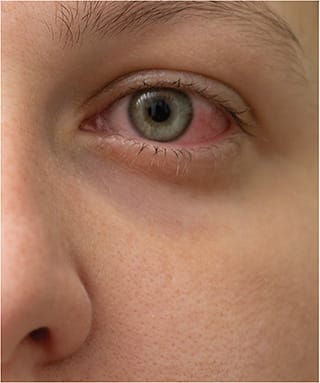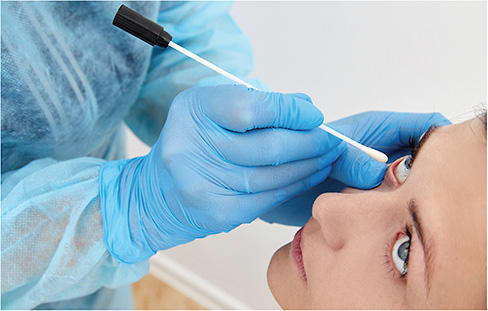The global outbreak of the severe acute respiratory syndrome coronavirus-2 (SARS-CoV-2), also named the coronavirus disease 2019 (COVID-19), unfortunately remains a global health threat, most recently with the Delta variant of the virus taking center stage. Reports have highlighted conjunctivitis as the main ocular manifestation of SARS-CoV-2-infected patients.1-4 (See “Ocular Transmission: An Overview,” below.)
In fact, some studies have suggested that conjunctivitis can present as the first sign of SARS-CoV-2 prior to the onset of systemic symptoms, such as fever, cough and shortness of breath.5-8 Other studies have demonstrated that conjunctivitis can present as the only manifestation of SARS-CoV-2.7-9 Interestingly, one study revealed 5 cases of acute follicular conjunctivitis as the sole expression of SARS-CoV-2.9
Given these facts, we should be on high alert for COVID-19 conjunctivitis. Here, we discuss its prevalence, diagnosis, and management. (See “Ocular Surface Disorders Associated With Severe COVID-19”.)
OCULAR TRANSMISSION: AN OVERVIEW
It has now been established that the spike protein from SARS-CoV-2 binds to the angiotensin-converting enzyme 2 (ACE2) cell-surface receptor, which serves as a key factor for cellular susceptibility.26,27
After the viral spike, protein binds to ACE2, a cell-surface-associated protease called transmembrane serine protease 2 (TMPRSS2) that plays an important role in allowing cell entry of SARS-CoV-2.28,29
These cell-surface components are present in nasal epithelial cells, and bronchial secretory cells. Further, the presence of ACE2 and TMPRSS2 have been predominantly found on the superficial epithelial surface of human conjunctival, limbal, and corneal cells.30
Although there is controversy on whether the conjunctiva truly serves as an important route for SARS-CoV-2 infections,2 there is accumulating evidence that the conjunctiva might have a role as an entry point and reservoir for the virus.1,3,31,32 Further, it is possible that other unidentified receptors in the conjunctiva could be involved in SARS-CoV-2 inoculation, although the viral replication rate in the conjunctiva remains unknown.14
Prevalence
While the literature has shown a wide incidence range (0.8% and 31.6%) of COVID-19 conjunctivitis, this can be explained by the heterogeneity of the studies.10 Specifically, some studies relied on questionnaires from infected patients after they were discharged from the hospital. Other studies reported ocular findings on hospitalized or critically ill SARS-CoV-2 patients without slit-lamp examination. Additionally, the ocular manifestations of the virus might be underestimated due to its secondary nature in an acute life-threatening situation. Thus, the true incidence of ocular findings in SARS-CoV-2 infections remains unclear. Nevertheless, the pooled data from a recent meta-analysis showed an incidence of 11.6% (95%CI= 5.5-17.7) for all ocular manifestations in COVID-19.8
There is additional controversy as to whether conjunctivitis is an early manifestation of the systemic SARS-CoV-2 disease, or whether it presents mainly in severe SARS-CoV-2 pneumonia. One meta-analysis study showed ocular symptoms as the first manifestation of SARS-CoV-2 pneumonia in 2.26% of patients (95%CI= 0.03-4.49), followed by systemic symptoms.,8 Others revealed conjunctival congestion 2 weeks after SARS-CoV-2 pneumonia symptom onset.4,11 When grouping non-hospitalized and hospitalized COVID-19 patients, only 6.9% (95%CI= 1.7–15.5) of patients with ocular manifestations presented with severe SARS-CoV-2 pneumonia.8 Patients with severe SARS-CoV-2 pneumonia who presented with conjunctivitis on hospital admission were associated with worse outcomes, likely due to a higher viral load.12
Diagnosis
In patients presenting with conjunctivitis, a thorough history, including exposure to SARS-CoV-2, history of vaccination, and recent fever, cough, or shortness of breath are suspicious for COVID-19 conjunctivitis.
It is important to highlight that patients who have breakthrough infections after receiving their full vaccination dose seem to acquire a milder form of the disease. It is still unknown at the moment how vaccination status impacts the ocular manifestations. Therefore, ophthalmologists should maintain suspicion of COVID-19 conjunctivitis in fully vaccinated patients who have ocular symptoms, and had a recent history of exposure to confirmed patients.
Something else to consider: The most common ocular signs and symptoms have been conjunctival chemosis, ocular pain 31.2% (95%CI= 23.7-38.7), conjunctival redness or congestion 10.8% (95%CI= 3.0-18.7), follicular conjunctivitis 7.0% (95%CI= 2.1-11.8), and itching 6.55% (95%CI= 0.2-12.8).8 The average duration of conjunctival congestion was 5.9 ± 4.5 days.11
To confirm the diagnosis, a conjunctival swab with reverse transcriptase–polymerase chain reaction (RT-PCR) analysis may be helpful in early disease.2 One study, for example, showed a positive yield in 24% of RT-PCR data when tear samples were collected from both eyes with conjunctival swabs.2 Other studies have revealed an overall low yield (0 to 7%) for detection of viral nucleic acid in conjunctival or tear samples.2,13 These findings may suggest a low viral replication in the conjunctiva.14 That said, the inconsistencies in the results from various studies can also be attributed to the differences in the collection methods, the collected volume, and timing of the swabs during the course of the disease.2,7
One hypothesis is that viral replication in the conjunctiva is higher in early disease. Hence, by the time the virus invades the nasopharyngeal and respiratory tract, and pneumonia symptoms are evident, the viral load is low in the conjunctiva with a low positive yield on ocular swabs.1,7 In moderate-to-severe COVID-19 pneumonia, the higher positive yield is likely explained by the greater systemic viral load in these patients, where the clinical outcomes are worse.3 Another hypothesis is that the eye is a conduit for viral spread, where the virus does not gain cell entry directly through the ocular surface, but migrates from the nasolacrimal to the respiratory mucosa to cause infections.15,16

Management
COVID-19 conjunctivitis is self-limiting, like other forms of viral conjunctivitis.14
Supportive management is indicated with frequent cold compresses, and preservative-free artificial tears (every 1 to 2 hours) for 7 days. If symptoms do not resolve after 7 to 10 days, complications or other causes should be considered.
Two case reports of acute bilateral follicular conjunctivitis in SARS-CoV-2 positive patients improved within 4 days of topical ribavirin and ganciclovir use, respectively.4,17 However, their use is off-label, as there is no evidence of their benefit for SARS-CoV-2 conjunctivitis. Moreover, the ocular manifestations likely improve secondary to systemic medications when these are indicated for systemic disease.18 Nonetheless, systemic medications are not indicated solely for conjunctivitis treatment.
Topical povidone iodine has been suggested as a possible prophylaxis during accidental ocular exposure to SARS-CoV-2.19 Although it has been found highly effective against coronavirus in vitro,20,21 more evidence is required to establish ocular povidone iodine treatment as a post-exposure prophylaxis. Its role and safety are well-established in ophthalmology for preoperative antisepsis, thus its high anti-coronavirus activity is reassuring in this setting.22

OCULAR DISORDERS ASSOCIATED WITH SEVERE COVID-19
It is known that critically ill patients who require mechanical ventilation or high-flow oxygen are at risk for developing ocular surface disorders from mild exposure keratitis to severe infectious keratitis.33
These patients may present with a decreased blink reflex, increased tear evaporation, carbon dioxide retention, reduced venous return from the eye, renal failure, cardiopulmonary failure, and exposure to multi-resistant pathogens, which predispose the ocular surface to injury.7
Thus, it is important to adopt safety precautions on critically ill SARS-CoV-2 patients to prevent permanent visual loss. Such measures include proper mask fitting, proper eye seal with gel-formulated lubricant drops in sedated patients, daily assessment of the ocular surface integrity, and early intervention when possible.33
Protection is Paramount
COVID-19 has affected over 200 million people and caused closed to 5 million deaths worldwide, as of current press. The common initial symptoms of this airborne pathogen are cough, fever, sore throat, fatigue, and headaches, among others.23-25 Given the susceptibility of the ocular surface to viral infections, and its potential reservoir function for person-to person transmission, safety precautions, including protective eye gear and face shields, and hand hygiene and avoidance of hands to the face and eyes are prudent in preventing SARS-CoV-2 spread, specifically during exposure to infected patients. These recommendations should be encouraged until there is more substantial data confirming otherwise. CP

References:
- Liang L, Wu P. There may be virus in conjunctival secretion of patients with COVID-19. Acta Ophthalmol. 2020;98(3):223.
- Arora R, Goel R, Kumar S, et al. Evaluation of SARS-CoV-2 in tears of patients with moderate to severe COVID-19. Ophthalmology. 2021;128(4):494-503.
- Wu P, Duan F, Luo C, et al. Characteristics of ocular findings of patients with coronavirus disease 2019 (COVID-19) in Hubei Province, China. JAMA Ophthalmol. 2020;138(5):575-578.
- Chen L, Liu M, Zhang Z, et al. Ocular manifestations of a hospitalised patient with confirmed 2019 novel coronavirus disease. Br J Ophthalmol. 2020;104(6):748-751.
- Cheema M, Aghazadeh H, Nazarali S, et al. Keratoconjunctivitis as the initial medical presentation of the novel coronavirus disease 2019 (COVID-19). Can J Ophthalmol. 2020;55(4):e125-e129.
- Khavandi S, Tabibzadeh E, Naderan M, Shoar S. Corona virus disease-19 (COVID-19) presenting as conjunctivitis: atypically high-risk during a pandemic. Cont Lens Anterior Eye. 2020;43(3):211-212.
- Ho D, Low R, Tong L, Gupta V, Veeraraghavan A, Agrawal R. COVID-19 and the ocular surface: a review of transmission and manifestations. Ocul Immunol Inflamm. 2020;28(5):726-734.
- Aggarwal K, Agarwal A, Jaiswal N, et al. Ocular surface manifestations of coronavirus disease 2019 (COVID-19): A systematic review and meta-analysis. PLoS One. 2020;15(11):e0241661.
- Scalinci SZ, Trovato Battagliola E. Conjunctivitis can be the only presenting sign and symptom of COVID-19. IDCases. 2020;20:e00774.
- Seah IYJ, Anderson DE, Kang AEZ, et al. Assessing viral shedding and infectivity of tears in coronavirus disease 2019 (COVID-19) patients. Ophthalmology. 2020;127(7):977-979.
- Chen L, Deng C, Chen X, et al. Ocular manifestations and clinical characteristics of 535 cases of COVID-19 in Wuhan, China: a cross-sectional study. Acta Ophthalmol. 2020;98(8):e951-e959.
- Loffredo L, Pacella F, Pacella E, Tiscione G, Oliva A, Violi F. Conjunctivitis and COVID-19: A meta-analysis. J Med Virol. 2020;92(9):1413-1414.
- Karimi S, Arabi A, Shahraki T, Safi S. Detection of severe acute respiratory syndrome Coronavirus-2 in the tears of patients with Coronavirus disease 2019. Eye (Lond). 2020;34(7):1220-1223.
- Bertoli F, Veritti D, Danese C, et al. Ocular findings in COVID-19 patients: a review of direct manifestations and indirect effects on the eye. J Ophthalmol. 2020;2020:4827304.
- Seah I, Agrawal R. Can the coronavirus disease 2019 (COVID-19) affect the eyes? A review of coronaviruses and ocular implications in humans and animals. Ocul Immunol Inflamm. 2020;28(3):391-395.
- Lange C, Wolf J, Auw-Haedrich C, et al. Expression of the COVID-19 receptor ACE2 in the human conjunctiva. J Med Virol. 2020;92(10):2081-2086.
- Sirakaya E, Sahiner M, Aslan Sirakaya H. A patient with bilateral conjunctivitis positive for SARS-CoV-2 RNA in a conjunctival sample. Cornea. 2021;40(3):383-386.
- Sarma P, Kaur H, Kumar H, et al. Virological and clinical cure in COVID-19 patients treated with hydroxychloroquine: A systematic review and meta-analysis. J Med Virol. 2020;92(7):776-785.
- Sarma P, Kaur H, Medhi B, Bhattacharyya A. Possible prophylactic or preventive role of topical povidone iodine during accidental ocular exposure to 2019-nCoV. Graefes Arch Clin Exp Ophthalmol. 2020;258(11):2563-2565.
- Kanagalingam J, Feliciano R, Hah JH, Labib H, Le TA, Lin JC. Practical use of povidone-iodine antiseptic in the maintenance of oral health and in the prevention and treatment of common oropharyngeal infections. Int J Clin Pract. 2015;69(11):1247-1256.
- Kariwa H, Fujii N, Takashima I. Inactivation of SARS coronavirus by means of povidone-iodine, physical conditions and chemical reagents. Dermatology. 2006;212 Suppl 1(Suppl 1):119-123.
- Koerner JC, George MJ, Meyer DR, Rosco MG, Habib MM. Povidone-iodine concentration and dosing in cataract surgery. Surv Ophthalmol. 2018;63(6):862-868.
- Lu R, Zhao X, Li J, et al. Genomic characterisation and epidemiology of 2019 novel coronavirus: implications for virus origins and receptor binding. Lancet. 2020;395(10224):565-574.
- Huang C, Wang Y, Li X, et al. Clinical features of patients infected with 2019 novel coronavirus in Wuhan, China. Lancet. 2020;395(10223):497-506.
- Guan WJ, Ni ZY, Hu Y, et al. Clinical characteristics of coronavirus disease 2019 in China. N Engl J Med. 2020;382(18):1708-1720.
- Lan J, Ge J, Yu J, et al. Structure of the SARS-CoV-2 spike receptor-binding domain bound to the ACE2 receptor. Nature. 2020;581(7807):215-220.
- Shang J, Ye G, Shi K, et al. Structural basis of receptor recognition by SARS-CoV-2. Nature. 2020;581(7807):221-224.
- Matsuyama S, Nao N, Shirato K, et al. Enhanced isolation of SARS-CoV-2 by TMPRSS2-expressing cells. Proc Natl Acad Sci USA. 2020;117(13):7001-7003.
- Hoffmann M, Kleine-Weber H, Schroeder S, et al. SARS-CoV-2 cell entry depends on ACE2 and TMPRSS2 and is blocked by a clinically proven protease inhibitor. Cell. 2020;181(2):271-280.e278.
- Zhou L, Xu Z, Castiglione GM, Soiberman US, Eberhart CG, Duh EJ. ACE2 and TMPRSS2 are expressed on the human ocular surface, suggesting susceptibility to SARS-CoV-2 infection. Ocul Surf. 2020;18(4):537-544.
- Loon SC, Teoh SC, Oon LL, et al. The severe acute respiratory syndrome coronavirus in tears. Br J Ophthalmol. 2004;88(7):861-863.
- Colavita F, Lapa D, Carletti F, et al. SARS-CoV-2 isolation from ocular secretions of a patient with COVID-19 in Italy with prolonged viral RNA detection. Ann Intern Med. 2020;173(3):242-243.
- Sansome SG, Lin PF. Eye care in the intensive care unit during the COVID-19 pandemic. Br J Hosp Med (Lond). 2020;81(6):1-10.










